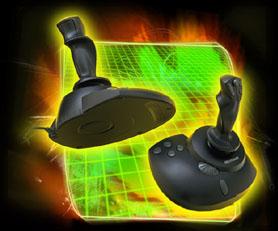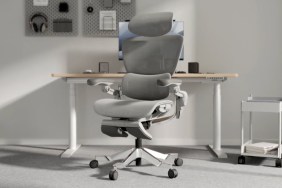Quick ‘n Accurate
I’ve always hated bad joysticks. You probably know them.
They’re uncomfortable, inaccurate, two-button, analog pieces of
junk. I was then very glad to be able to try out Microsoft’s
Sidewinder Precision Pro Microsoft has been developing a
reputation for designing high-quality game devices for their
Sidewinder line. I am pleased to say that they are carrying on
that tradition with the Precision Pro.
The Sidewinder Precision Pro is Microsoft’s newest
non-force feedback joystick. It is the successor to the
Sidewinder Pro. The Precision Pro is an all-digital
joystick. This means that you never need to recalibrate the
thing. It used infrared beams of light to ensure accurate
movement and no drift. The Sidewinder’s all-digital nature is a
blessing for those who seek accuracy and quality in their
joystick, but it can also cause problems on
some sound cards.
If you have one of these problem sound cards, you should think
long and hard before you buy this joystick, as you may have major
difficulties when trying to use it.
The Sidewinder has a standard 2-axis stick, plus a rudder control
in the form of a twistable handle, which can be used in some
games. The main stick has 4 buttons, which are placed more
naturally than on the Sidewinder Pro, as well as a hat
switch, which can be used to control the viewing direction. On
the base of the stick, there are 4 other buttons, a throttle
control, and a ‘shift’ key. You might be wondering why you need
all these buttons. After all, most games have actions for 2 or
at most 4 joystick buttons. This is where the Sidewinder’s
software comes in.
The Sidewinder uses profiles to control the
functions of the stick. Each profile allows the user to set
keystroke combinations for each button and each shifted button.
This allows you to use up to 16 combinations per profile. Adding
to the joystick’s flexibility is the fact that you can switch
between profiles by simply calling up the profile manager. 30
profiles for popular games have been included, and it is quite
easy to change them or to make your own. One weakness that I
noticed is that you are unable to assign keystrokes to rudder
control, hat-switch, throttle, or basic movements. This would
have let the user use the Sidewinder even in games which are
keyboard based, or assign the throttle, hat-switch, and rudder
functions to keyboard commands in games which do not use these
features.
Despite these annoyances, I found the Sidewinder Precision
Pro very useful in most games. Its button layout is much
more convenient than the earlier Sidewinder, and its full
complement of buttons and programmability makes it invaluable in
flight sims and fighting games. While I would not recommend the
Sidewinder Precision Pro to current owners of a high quality
joystick, I would recommend it to anyone looking for an accurate,
drift free, programmable joystick. Another joystick to consider
would be the Sidewinder Force-feedback joystick, but it costs
about twice that of the Precision Pro, and can cause
soreness in some users. If you use a joystick a lot, and are
stuck with one of those $10 models, you will wish you had bought
the Sidewinder Precision Pro a long time ago.











